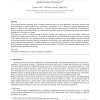Free Online Productivity Tools
i2Speak
i2Symbol
i2OCR
iTex2Img
iWeb2Print
iWeb2Shot
i2Type
iPdf2Split
iPdf2Merge
i2Bopomofo
i2Arabic
i2Style
i2Image
i2PDF
iLatex2Rtf
Sci2ools
GANDC
2011
2011
Adjacent versus coincident representations of geospatial uncertainty: Which promote better decisions?
3D geological models commonly built to manage natural resources are much affected by uncertainty because most of the subsurface is inaccessible to direct observation. Appropriate ways to intuitively visualize uncertainties are therefore critical to draw appropriate decisions. However, empirical assessments of uncertainty visualization for decision making are currently limited to two-dimensional map data, while most geological entities are either surfaces embedded in a 3D space or volumes. This paper first reviews a typical example of decision making under uncertainty, where uncertainty visualization methods can actually make a difference. This issue is illustrated on a real Middle East oil and gas reservoir, looking for the optimal location of a new appraisal well. In a second step, we propose a user study that goes beyond traditional 2D map data, using 2.5D pressure data for the purposes of well design. Our experiments study the quality of adjacent versus coincident representations ...
| Added | 22 Dec 2011 |
| Updated | 22 Dec 2011 |
| Type | Journal |
| Year | 2011 |
| Where | GANDC |
| Authors | Thomas Viard, Guillaume Caumon, Bruno Lévy |
Comments (0)

